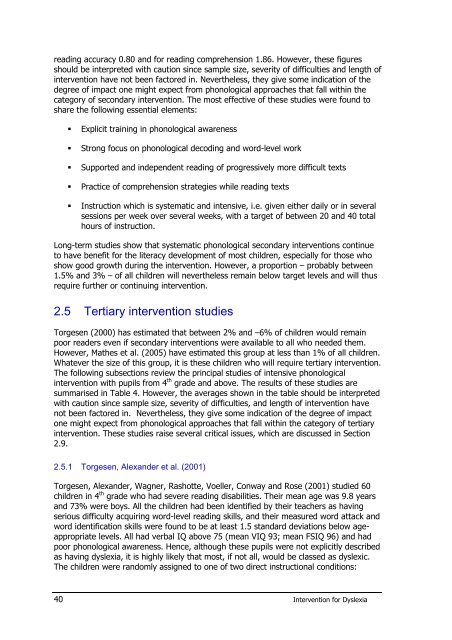Intervention for Dyslexia - The British Dyslexia Association
Intervention for Dyslexia - The British Dyslexia Association
Intervention for Dyslexia - The British Dyslexia Association
You also want an ePaper? Increase the reach of your titles
YUMPU automatically turns print PDFs into web optimized ePapers that Google loves.
eading accuracy 0.80 and <strong>for</strong> reading comprehension 1.86. However, these figures<br />
should be interpreted with caution since sample size, severity of difficulties and length of<br />
intervention have not been factored in. Nevertheless, they give some indication of the<br />
degree of impact one might expect from phonological approaches that fall within the<br />
category of secondary intervention. <strong>The</strong> most effective of these studies were found to<br />
share the following essential elements:<br />
Explicit training in phonological awareness<br />
Strong focus on phonological decoding and word-level work<br />
Supported and independent reading of progressively more difficult texts<br />
Practice of comprehension strategies while reading texts<br />
Instruction which is systematic and intensive, i.e. given either daily or in several<br />
sessions per week over several weeks, with a target of between 20 and 40 total<br />
hours of instruction.<br />
Long-term studies show that systematic phonological secondary interventions continue<br />
to have benefit <strong>for</strong> the literacy development of most children, especially <strong>for</strong> those who<br />
show good growth during the intervention. However, a proportion – probably between<br />
1.5% and 3% – of all children will nevertheless remain below target levels and will thus<br />
require further or continuing intervention.<br />
2.5 Tertiary intervention studies<br />
Torgesen (2000) has estimated that between 2% and –6% of children would remain<br />
poor readers even if secondary interventions were available to all who needed them.<br />
However, Mathes et al. (2005) have estimated this group at less than 1% of all children.<br />
Whatever the size of this group, it is these children who will require tertiary intervention.<br />
<strong>The</strong> following subsections review the principal studies of intensive phonological<br />
intervention with pupils from 4 th grade and above. <strong>The</strong> results of these studies are<br />
summarised in Table 4. However, the averages shown in the table should be interpreted<br />
with caution since sample size, severity of difficulties, and length of intervention have<br />
not been factored in. Nevertheless, they give some indication of the degree of impact<br />
one might expect from phonological approaches that fall within the category of tertiary<br />
intervention. <strong>The</strong>se studies raise several critical issues, which are discussed in Section<br />
2.9.<br />
2.5.1 Torgesen, Alexander et al. (2001)<br />
Torgesen, Alexander, Wagner, Rashotte, Voeller, Conway and Rose (2001) studied 60<br />
children in 4 th grade who had severe reading disabilities. <strong>The</strong>ir mean age was 9.8 years<br />
and 73% were boys. All the children had been identified by their teachers as having<br />
serious difficulty acquiring word-level reading skills, and their measured word attack and<br />
word identification skills were found to be at least 1.5 standard deviations below ageappropriate<br />
levels. All had verbal IQ above 75 (mean VIQ 93; mean FSIQ 96) and had<br />
poor phonological awareness. Hence, although these pupils were not explicitly described<br />
as having dyslexia, it is highly likely that most, if not all, would be classed as dyslexic.<br />
<strong>The</strong> children were randomly assigned to one of two direct instructional conditions:<br />
40 <strong>Intervention</strong> <strong>for</strong> <strong>Dyslexia</strong>









